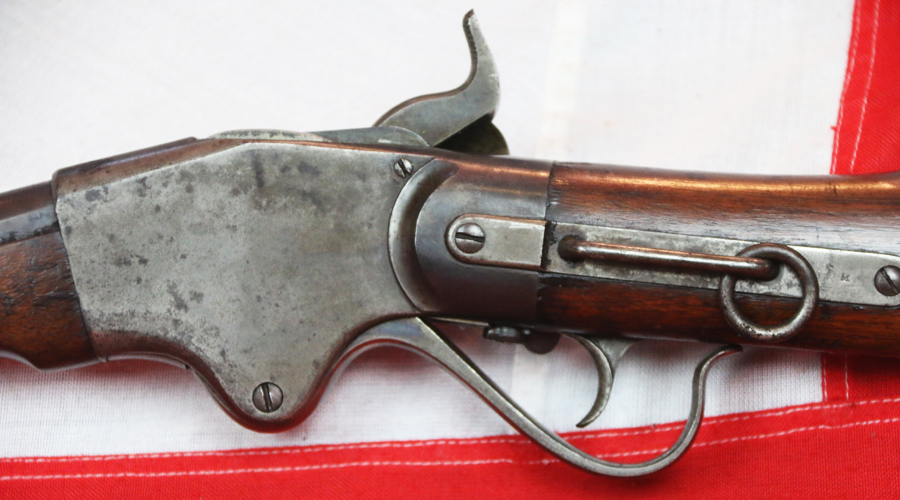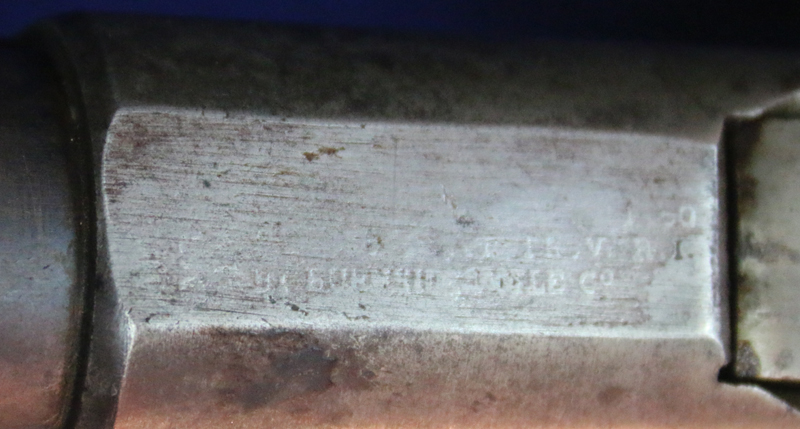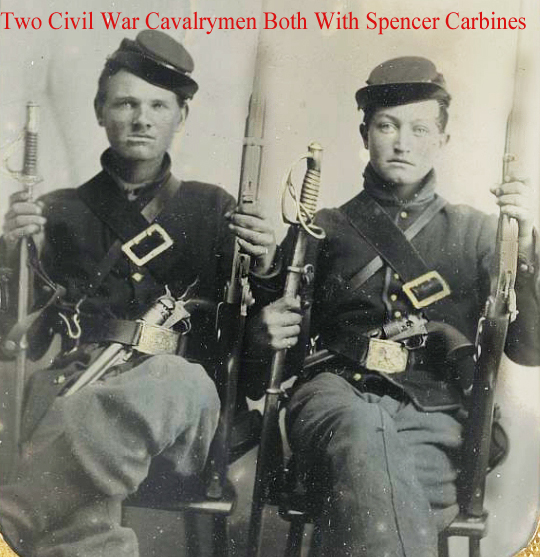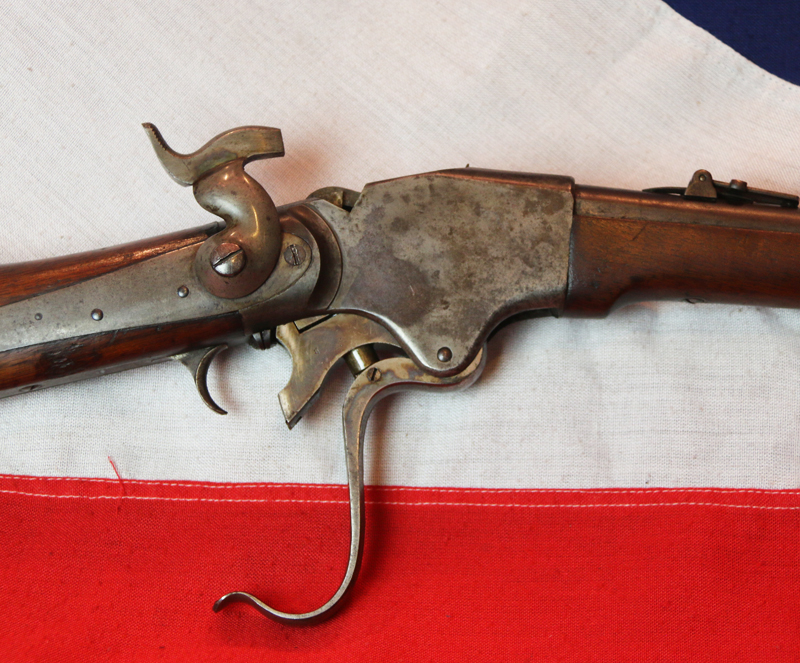A Superb Spencer Carbine, The Best Carbine Rifle of the American Civil War, & The Wild West. One of The 500 Guns Of The ‘Colorado Shipment’ & Used In The ‘Post Colorado War’ Indian Wars, Between the Southern Cheyenne, Arapaho, & Brulé and Oglala Sioux
An absolutely cracking example in superb condition for age, probably one of the best we have seen in years, and comparable or possibly better to one we had last year, which was, until then, the finest we had seen anywhere in the last 10 years. Complete with its removable and reloadable magazine. Serial numbered 33k range.
It bears a US inspector’s cartouche stamp on the stock, and that particular inspector is seen on the Colorado issue range, within the 33k serial numbered guns, this is rare in that only 500 carbines from this serial numbered range were transferred to the Colorado territory, and this is only the second we have ever seen, both in that rarely seen 33k serial number sequence.
Colorado, in the world famous Rocky Mountains aka ‘The Rockies’, was at the very heart of what is known today as the “Wild West’ period, and it went through an incredible series of historical events at this time, it was not granted statehood till August 1st 1876, as President Andrew Jackson vetoed it in 1865, it had an amazing and violent ‘Gold Rush’ period during the war, and it was experiencing all manner of difficulties and dangers regarding the breaking of the Fort Laramie Treaty, which became known as the the Colorado War, between the warring Native American tribes, such as between the Southern Cheyenne, Arapaho, and allied Brulé and Oglala Sioux. It became the centre of so many Hollywood ‘Wild West’ films in the entire 20th century, in the telling of the stories of Colorado and ‘The Rockies’ that one way or another it became one of the most famous territories and states of America around the world.
In modern movie times the 1860 Spencer Rifle was used by Clint Eastwood and Morgan Freeman in ‘The Unforgiven’ and in ‘3.10 to Yuma’ by Christin Bale
The Spencer was the most advanced infantry weapon in the world of its times, it was patented in 1860 by Christian Spencer, a machinist who worked in Hartford. Conn. For Sharps and developed the Spencer on his own time. We are offering this simply superb example that is in great condition for its age. This carbine was a fundamental game changer of the entire Civil War. Although Confederates captured some of these weapons, the South's armament industry was unable to manufacture much of the ammunition due to a shortage of copper. It is only a small exaggeration to state that this cartridge decided the outcome of the Civil War.
Col. John T. Wilder said of them:"Hoover's Gap was the first battle where the Spencer repeating rifle had ever been used, and in my estimation they were better weapons that has yet taken their place, being strong and not easily injured by the rough usage of army movements, and carrying a projectiile that disabled any man who was unlucky enough to be hit by it." One of his soldiers wrote about the Spencer that it "never got out of repair. It would shoot a mile just as accurately as the finest rifle in the world. It was the easiest gun to handle in the manual of arms drill I have ever seen. It could be taken all to pieces to clean, and hence was little trouble to keep in order -- quite an item to lazy soldiers." According to Smith Aktins, a colonel in Wilder's regiment, it was "the best arm for service in the field ever invented, better than any other arm in the world then or now, so simple in its mechanism that it never got out of order, and was always ready for instant service.".
Major-General James H. Wilson, who was instrumental in crushing Hood at Nashville (15-16 Dec. 1864) and defeated Forrest at Selma (2 April 1865), wrote the following about them: "There is no doubt that the Spencer carbine is the best fire-arm yet put into the hands of the soldier, both for economy of ammunition and maximum effect, physical and moral. Our best officers estimate one man armed with it is equivalent to three with any other arm. I have never seen anything else like the confidence inspired by it in the regiments or brigades which have it. A common belief amongst them is if their flanks are covered they can go anywhere. I have seen a large number of dismounted charges made with them against cavalry, infantry, and breast-works, and never knew one to fail. It was the world's first practical repeater and fired a .52 calibre metallic rimfire cartridge (patented by Smith & Wesson in 1854 and perfected by Henry in the late 1850's} which completely prevented gas leakage from the back because the brass casing expanded on ignition to seal the chamber. It had a "rolling block" (actually a rotating block) activated by lowering the trigger guard. This movement opened the breech and extracted the spent cartridge. Raising the lever caused a new cartridge, pushed into position by a spring in the 7-round magazine, to be locked into the firing chamber. The 7-round magazine was located in the stock.
The Spencer was easy to manufacture (given the requisite industrial infrastructure), had relatively few parts, many of which were in common with the Sharps rifles, and was cheaper than other repeaters on the market such as the Henry. It also turned out to be extremely reliable under battlefield conditions. Its great advantage over the muzzle loading rifles such as the Enfields and Springfields lay not only in the rapidity of fire, but also in the ability of the shooter to aim each shot. In a normal battle situation, the muzzle loaders were fired in an aimed manner only the first few shots, thereafter it was usually a case of hurried fire after frantic loading. A trained soldier could get off two or three shots a minute with them until the barrel fouled with lead deposit. With the Spencer the soldier could fire 20 to 30 times a minute when necessary, taking advantage of the cartridge box which held 10 preloaded magazines. The only disadvantage of the Spencers was the relatively small powder charge in the cartridge which limited its range. Some marksmen therefore preferred the single shot Sharps breechloader which used paper or linen cartridges with a larger powder charge and had greater range. With the Sharps you could fire about 10 times a minute. But for the cavalry which fought mostly at close range, the Spencer was the weapon of choice.
Introduced in Jan. 1862, it found its first major use by Col. John Wilder's Indiana "Lightning Brigade" of mounted infantry at Hoover's Gap during the Tullahoma Campaign (22 June - 3 July 1863). The firepower and speed of this unit overwhelmed Wheeler's cavalry guarding the southern end of this pass and allowed George H. Thomas's 14th infantry corps to place itself on the flank of the Confederate General Hardee. This sudden development misled Hardee into thinking he had been outflanked by the entire Union Army of the Cumberland, and he retreated without orders back to Tullahoma, 15 miles in his rear. Wilder then spearheaded the turning movement to the east of Tullahoma, and this in turn undermined Bragg's entire defensive line, and he had to pull back into Chattanooga. At the price of about 500 casualties the Union Army advanced 100 miles and made military history. Later, at the battle of Chickamauga (19-20 Sept. 1863), his troops used them with decisive effect on the first day, keeping Bragg's troops from cutting the road to Chattanooga, and slowing Longstreet's attack on the second day. This is the scarcer Burnside Spencer Repeating Rifle Contract Carbine,
Made in Providence Rhode Island This specimen is one of the Burnside Contract, making it much scarcer and thus rarer than those standard carbines made by the Spencer Repeating Rifle Company. Out of the 34,000 made by Burnside, over 30,000 were purchased by the U.S. government, which in gun production numbers, during this period, 30,000 was a most small contract indeed.
On October 16, 1868, 500 Burnside Contract Spencer Carbines were transferred by the Ordnance Department to the Colorado Territory. The Ordnance inspector cartouche remain visible on the left side of the stock behind the sling ring bar, this particular Ordnance stamp is also the ones used for the 500 Colorado Territory guns shipment.
Thousands of people had flooded into Colorado between 1858-1861 trying to find quick riches. As a result, the Colorado territory was born. This was the first time that a concentrated group of people had began to settle the region. It was almost immediately filled with wealth, trade, and rail transportation. By 1865, more than 1 million ounces of gold had been found. But this now overpopulated area had spilt out and violated an already unstable situation; The Treaty of Fort Laramie had been broken. The Treaty was meant to establish boundaries and offer peace, internally and externally, among both the United States and Natives. The American miners settling on the Native land only exaggerated the existing conflicts between tribes. The result ended up being years of war between multiple tribes and the U.S. Government, in what is now known as the Colorado War.
As the conflicts ceased, population growth flourished, and resources kept flowing, the territory became a state on August 1, 1876. Colorado could have been a state a little sooner if President Andrew Jackson didn’t issue a veto against the statehood in 1865. A lot of American history happened in a short span of time. Colorado played a huge role in the history of the American West, making the potential of this rifle in our opinion very special indeed.
As with all our antique guns no license is required as they are all unrestricted antique collectables
Code: 23152
4750.00 GBP










